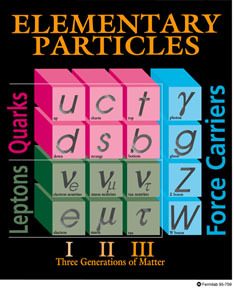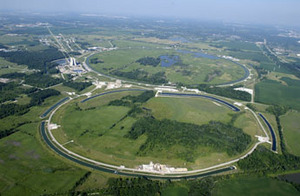Six Louisiana Tech researchers in the physics department played a role in discovering a new sub-atomic particle whose existence was announced this week.
The discovery was made by physicists of the DZero experiment at the U.S. Department of Energy's Fermi National Accelerator Laboratory in Batavia, Ill.
Discovery and measurement of the particle's mass will provide new understanding about the basic building blocks of matter.
Local participants in the experiment were physics faculty members Z.D. Greenwood, Lee Sawyer and Markus Wobisch; former post-doctoral researcher Julie Kalk; and current post-doctoral researchers Mike Arov and Joe Steele.
"We've never seen anything like this before," said Sawyer, who is academic director of Tech's physics and chemistry programs. "What is really neat about this is that we have models that predict these things' existence. Discovery is verification of the Standard Model of particle physics."

|
| ©Fermilab
|
| Six quarks -- up, down, strange, charm, bottom and top -- are the building blocks of matter. Protons and neutrons are made of up and down quarks, held together by the strong nuclear force. The DZero experiment, in which six Louisiana Tech researchers participated, has discovered the cascade-b particle, which contains a down quark (d), strange quark (s) and bottom quark (b). It is the first particle ever observed with one quark from each generation of particles.
|
Details of the discovery will be presented at a special Fermilab seminar at 1 p.m. Friday, June 15. The DZero experiment reported the discovery of the particle in a paper submitted June 12 to Physical Review Letters, the Journal of the American Physical Society.
A news release from Fermilab provided the following information:
- The newly discovered heavy particle is a baryon known as the "cascade b."
- "A baryon is a particle of matter made of three fundamental building blocks called quarks. The most familiar baryons are the proton and neutron of the atomic nucleus ... Baryons composed of heavier quarks, including the cascade b, were abundant soon after the Big Bang at the beginning of the universe."
- The discovery and measurement of cascade b's mass provide new insight into how the strong nuclear force acts upon those basic building blocks of matter.
- Cascade b is the first observed baryon formed of quarks from all three families of matter.
- Prior to this discovery, only indirect evidence for cascade b had been reported by experiments at the Large Electron-Positron collider at the CERN Laboratory near Geneva, Switzerland.
- Cascade b is produced in high-energy proton-antiproton collisions at Fermilab's Tevatron device.

|
| ©Fermilab
|
| The Fermilab accelerator complex in Illinois accelerates sub-atomic particles close to the speed of light. Converting energy into mass, the Tevatron collider produces millions of proton-antiproton collisions per second, maximizing the chance for discovery of new particles. Six Louisiana Tech researchers helped in the discovery process.
|
Physicist Robin Staffin, associate director for high-energy physics for the Department of Energy's Office of Science, said:
"Knowing the mass of the cascade b baryon gives scientists information they need in order to develop accurate models of how individual quarks are bound together into larger particles such as protons and neutrons."
DZero is an international experiment of about 610 physicists from 88 institutions in 19 countries. It is supported by the Department of Energy, the National Science Foundation and a number of international funding agencies. Fermilab is a national laboratory funded by DOE's Office of Science, operated under contract by Fermi Research Alliance.
More information can be found at
this Fermilab Web site.
Reader Comments
to our Newsletter